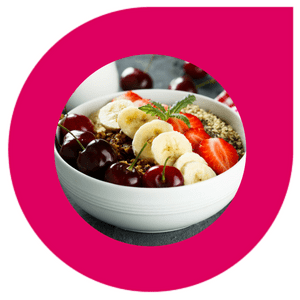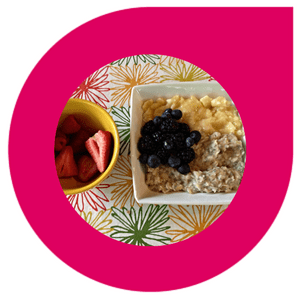
If the arrival of summer finds you brimming with motivation to lead a healthier, happier life, great! But with so much information and advice out there, where do you start?
First things first – ditch the diet. Throw out the whole concept of dieting and other health fads and get ready to build healthy habits for life with an entirely new approach to healthy eating.
 Start Afresh
Start Afresh
If you, like many people, have gotten stuck in a pattern of yo-yo dieting, dropping and gaining weight over and over again, it’s time to take a step back and start afresh.
The best way to approach healthy eating is to think about how to best fuel your body for life, not just for today. No more three-week diet plans with cheat days. No more ten-day detox diets that leave you hungry and cranky. Instead, it’s time to adopt consistent, healthy practices that are smart, achievable, realistic, and sustainable.
What this looks like in practice will depend on your individual circumstances, including finances, current health status, family obligations, your schedule, and other factors. To help get you started, here are five strategies for lifelong healthy eating:
1. Clear out Your Cupboards
Clear out your cupboards and freezer of anything that you wouldn’t consider healthful. Box it up and take it to the food bank, or give it to family, friends, and neighbours.
So, what are you getting rid of? Cookies, chips, candy, bacon, white rice, canned fruit in syrup, and other high-sugar, high-saturated fat, and nutrient-poor foods.
2. Stock up on Staple Foods
There’s nothing better than a pantry packed with healthy foods to pull from when you’re making meals at home. A healthy pantry should include:
- Whole grains (quinoa, brown rice, barley, oats)
- Dried beans and lentils
- Low-sodium or unsalted crushed tomatoes in non-BPA cans
- Condiments like nutritional yeast and soy sauce
- Herbs and spices to flavour food and add nutrients
Stock up your freezer with frozen fresh fruits and vegetables, with no syrups, sugar, or salt added. This way, you’ll have everything you need on have to pull together a simple, tasty, and nutritious meal or snack.
 3. Make Healthy Meals in Bulk
3. Make Healthy Meals in Bulk
If you have more time to cook on the weekends then do the bulk of your food preparation and cooking then. Things like veggie chili, a Thai green curry with fresh vegetables, and a barley, vegetable and lentil soup can be quickly warmed up and served with brown rice or quinoa when you get home from work.
Leftovers make for easy, healthy lunches too! And, you can save time by chopping vegetables on the weekend and storing them in individual containers. Then you’ll have a batch of healthy on-the-go snacks ready for work and after-school activities.
4. Engage Family and Friends
If you work better when you’re accountable to others, announce your intention to eat a consistently healthy diet to your friends, family, and colleagues. Once you tell them that you’ll be eating a delicious and nutritious salad at work every day, rather than grazing on cookies and expensive sandwiches. They will likely notice (and comment!) if they don’t see you eating that salad.
The same goes for making meals at home. Make healthy your new normal. Soon, your spouse, kids, friends, or other dinnertime companions will come to expect and enjoy a nutritious meal.
5. Harness the Power of Habit and Identity
By taking steps to establish a routine of eating a whole food diet that includes fresh vegetables, whole grains, nuts, seeds, pulses and legumes, there will be little need to avoid daily temptation.
Research shows that a strong sense of identity is incredibly helpful in staying motivated to consistently engage in behaviours associated with that identity. Being a healthy eater is like being someone who brushes their teeth or being a voter. Naturally, if you are someone who brushes their teeth, it would feel weird for you not to brush your teeth at least twice a day, right?
And now, thanks to your new start this summer, you identify as a healthy eater! You are now a person who picks a side salad over fries, says “no thanks” to cookies and cakes, and who brings your own healthy lunch to work every day. So, just as you might be a voter, a dog lover, a reader, a prize-winning grower of orchids, congratulations – you are now a healthy eater too!
References:
Bryan, C. J., Walton, G. M., Rogers, T., & Dweck, C. S. (2011). Motivating voter turnout by invoking the self. Proceedings of the National Academy of Sciences, 108(31), 12653-12656.


 2. Embrace Sunday Meal Prep
2. Embrace Sunday Meal Prep 4. Grow Your Own Herbs
4. Grow Your Own Herbs
 The Breakfast Bowl
The Breakfast Bowl Overnight Breakfast Bowls
Overnight Breakfast Bowls
 2. Tofu Scramble
2. Tofu Scramble 4. Savoury Oatmeal and Lentils
4. Savoury Oatmeal and Lentils
 1. Making the Same Resolution Every Year
1. Making the Same Resolution Every Year How to Set Specific Goals
How to Set Specific Goals
 Problems with the BMI
Problems with the BMI Alternative to the BMI
Alternative to the BMI
 1. Plan, Plan, Plan
1. Plan, Plan, Plan 3. Build Stronger Communities through Sharing Food
3. Build Stronger Communities through Sharing Food
 Apple and Rhubarb
Apple and Rhubarb Fall Greens
Fall Greens
 Learning to Differentiate Between Cravings and Hunger
Learning to Differentiate Between Cravings and Hunger Try PGX!
Try PGX!
 Water and Our Body
Water and Our Body The Benefits of Infused Water
The Benefits of Infused Water How to Infuse Water
How to Infuse Water